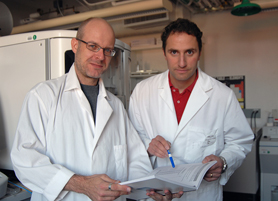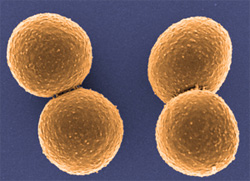MRSA Proves a Stubborn Opponent in Labs and Locker Rooms
In the fall of 2004, football coach Rocky Rawls led his high school team through practices in rural Bronte, Texas. At about the same time, in a Montana laboratory some 1,500 miles away, immunologist Frank DeLeo, Ph.D., and bacteriologist Michael Otto, Ph.D., were diagramming their own offensive and defensive strategies against an opponent common to Rawls: Staphylococcus aureus.
That season, a freshman on the Bronte (pronounced like "haunt") Longhorn football team missed most of the season after S. aureus bacteria invaded his skin through a cut and then worked its way into a bone. The bacteria were persistent—they didn’t respond to traditional antibiotics, and the student athlete spent more than 2 weeks in a hospital bed and underwent surgery to help clear the infection.
A year later, when practice for the 2005 season began, nearly a dozen more Bronte players showed signs of similar infection. Coaches, school administrators, and residents in the community of 1,000 people became increasingly concerned when two players ended up in the hospital and missed about half of the 2005 season; most other infected players missed at least an occasional game.
School officials decided to invite a regional physician and health department personnel to attend a town meeting, where residents heard that staph infections—considered manageable to their generation and the one before—now had become more severe and stubborn in the face of traditional antibiotic treatment.
The problem went beyond Bronte, beyond football, and beyond athletics. Across the country, public health officials observed that otherwise healthy people of all ages were at risk of acquiring staph infections that were easier than ever to obtain and harder and harder to stop. The risk extended to people who were confined in close areas or had skin-to-skin contact, such as wrestlers, gymnasts, correctional workers, military personnel, and day care center and long-term care facility employees.
"A lot of people in town thought it was in the carpet," inside the locker room, Rawls recalls. "But we learned that it’s everywhere on your skin and in your nose. I think how we got it—you never know for sure—during August practices that year it was so hot and there was no wind to dry their sweat. The players would get a cut or scratch during practice, and pretty soon it’d swell up."
Hamilton, Montana
 |
Michael Otto, left, and Frank DeLeo conferring inside their laboratory at Rocky Mountain Laboratories.
Credit: NIAID |
Back at the Montana laboratory, Drs. DeLeo and Otto were not surprised by an e-mail message that arrived on September 14, 2005, from a Texas physician who summarized the situation in Bronte and asked for assistance.
"My impression is they are spreading infection via protective gear, towels, or soap or a carrier," the doctor’s message read, requesting "sources I can use to help teach them to stop the infections."
The message was one of dozens with similar requests for assistance received in 2005 at Rocky Mountain Laboratories (RML), a research campus that is part of the National Institute of Allergy and Infectious Diseases (NIAID).
Inquiries began pouring in shortly after DeLeo and colleagues at RML published results of a study explaining how newly identified S. aureus strains can evade the immune response in healthy people with no known risk factors for infection. Those strains are now known as community-associated methicillin resistant S. aureus, or CA-MRSA.
“The response to that work from the general public was pretty amazing,” says Dr. DeLeo. That study and subsequent research have helped place the RML scientists at the forefront of CA-MRSA research.
Change is Good
 |
This colored electron micrograph shows isolated S. aureus bacteria that are resistant to many forms of antibiotics.
Credit: NIAID |
In 2003 – 2004, both scientists shifted their research focus to S. aureus on advice from mentor and former supervisor James Musser, M.D., Ph.D., now at The Methodist Hospital Research Institute in Houston.
"S. aureus was always important because of its effect on human health," says Dr. Otto. "It is not as exciting to a new researcher as, say, the agents of plague or anthrax. But staph is highly important, and Dr. Musser very early recognized its re-emergence as a human health threat."
When Dr. Musser hired Drs. DeLeo and Otto at RML, he encouraged them to immerse themselves in new technology and new ways of thinking. The offices and research staffs of the two scientists are adjacent to each other, which helps facilitate effective collaboration. They often review each other’s work and brainstorm together.
"These two investigators have really had wonderful opportunities and have made the most of those opportunities to move science and biomedical discoveries forward," Dr. Musser says.
Dr. DeLeo says Dr. Musser "“revolutionized RML by bringing macroscopic-level analyses and cutting-edge technologies and equipment to the campus.
"He challenged us to step back and see what happens to an organism or a host cell rather than just focusing on one aspect of disease and drilling down. How does it survive? How does it behave?"
Much of the new equipment practically allows scientists to climb inside DNA and observe the most intricate, intimate interactions between molecules. Because the equipment has only been available for a decade or less, the scientists say they feel fortunate that NIAID made an investment that has paid off so richly for their work at the right time.
Dr. Otto describes his collaboration with Dr. DeLeo this way: "Our interests and experiences complement each other very well. We can take a deeper look into the structure-function relationship between cells. We want to know how biological activities occur: What structural features are required and how do they perform? And we patiently look at these questions with multiple types of information available—electron micrographs, microarrays, genome sequences, liquid chromatography-mass spectometry, and mouse studies."
Common Problem-Solving
Bronte school officials also have used a macroscopic approach to try and curb their staph outbreak. They consulted with a physician and public health experts, looked at all likely sources of infection, and incorporated changes to reduce the risk. They used bleach to clean towels and player uniforms. They provided players with individual soap dishes. They used an antimicrobial "fog" product inside the school weight room and locker room.
"And now," Rawls says, "if a player gets a bad cut or scrape, rubbing alcohol goes on right away as a disinfectant."
Those are probably among the best approaches available for the time being, according to Drs. DeLeo and Otto, because they don’t see the S. aureus problem ending any time soon.
"I think one possible way to reduce risk of serious disease from CA-MRSA is to modify human behavior, for example, by focusing on better hygiene," Dr. DeLeo says. "Historically S. aureus comes in waves. It was resistant to penicillin, then methicillin… The wave is rising again."
Dr. Otto agrees, saying that CA-MRSA might soon become widely resistant to the few antibiotics remaining that prevent its spread, such as vancomycin. "That would be a huge catastrophe," he says, noting that physicians have reported a few cases of vancomycin-resistant S. aureus. "We have to put more efforts into finding novel treatments."
The RML researchers continue trying to help scientists get closer to that goal. Meanwhile, Bronte has begun its 2007 football season with a few new cases of staph infection among players—now a common occurrence at schools throughout the region according to a school administrator. The freshman who missed so much of the 2004 season is now a senior, fully recovered and playing football.
back to top